Effect of Blade Pitch Angle on the Aerodynamic Characteristics of a Straight-bladed Vertical Axis Wind Turbine Based on Experiments and Simulations
Abstract
1. Introduction
2. Theories and Methods
2.1. Theories
2.2. Methods
3. Results
4. Discussion
4.1. Pressure Distribution on Single Blade Surface
4.2. Torque Coefficient for Single Blade
4.3. Power Coefficient for the Wind Turbine
5. Conclusions
- (1)
- Blade pitch angle effect on pressure distribution acting on single blade surface. When the azimuth angle is in the upstream region, the pressure difference acting on the blade surface reaches maximum at the blade pitch angle of β = 6°. When the azimuth angle is in the downstream region, the pressure difference acting on the blade surface reaches maximum at the blade pitch angle of β = 8°.
- (2)
- Blade pitch angle effect on torque coefficient acting on single blade. When the azimuth angle is around θ = 100°, the torque coefficient acting on single blade reaches maximum at the pitch angle of β = 6°. When the azimuth angle is around θ = 260°, the maximum torque coefficient is obtained at the blade pitch angle of β = 8°.
- (3)
- Blade pitch angle effect on power coefficient. At the optimal tip speed ratio of λ = 2.19, the power coefficient is the largest when the blade pitch angle is β = 6°. Compared to HAWT, the blade pitch angle has no significant effect on the power coefficient.
Author Contributions
Acknowledgments
Conflicts of Interest
Nomenclature
| c | Blade chord (m) |
| CQ | Torque coefficient |
| Cp | Pressure coefficient |
| CPower | Power coefficient |
| D | Rotor diameter (m) |
| Fd | Drag force (N) |
| Fl | Life force (N) |
| FN | Normal force (N) |
| FT | Tangential force (N) |
| H | Spanwise length (m) |
| H0 | Numerical region height (m) |
| L0 | Numerical region length (m) |
| R0 | Rotor radius (m) |
| Re | Reynolds number |
| U0 | Mainstream wind velocity (m/s) |
| W | Resultant flow velocity to blade (m/s) |
| W0 | Numerical region width (m) |
| a | Angle of attack (°) |
| β | Blade pitch angle (°) |
| θ | Azimuth angle (°) |
| λ | Tip speed ratio |
| ρ | Air density (kg/m3) |
| ω | Angular frequency (rad/s) |
References
- CUI Minxuan. China Energy Development Report; Social Science Literature Publishing House: Beijing, China, 2010; pp. 152–170. [Google Scholar]
- Global Wind Report 2016. Available online: http://gwec.net/publications/global-wind-report-2/global-wind-report-2016 (accessed on 8 June 2018).
- Yu, W.; Zhang, M.M.; Xu, J.Z. Effect of smart rotor control using a deformable trailing edge flap on load reduction under normal and extreme turbulence. Energies 2012, 5, 3608–3626. [Google Scholar] [CrossRef]
- Siddiqui, M.S.; Durrani, N.; Akhtar, I. Quantification of the effects of geometric approximations on the performance of a vertical axis wind turbine. Renew. Energy 2015, 74, 661–670. [Google Scholar] [CrossRef]
- Dabiri, J.O. Potential order-of-magnitude enhancement of wind farm power density via counter-rotating vertical-axis wind turbine arrays. J. Renew. Sustain. Energy 2011, 3, 043104. [Google Scholar] [CrossRef]
- Galinos, C.; Larsen, T.J.; Madsen, H.A.; Paulsen, U.S. Vertical Axis Wind Turbine Design Load Cases Investigation and Comparison with Horizontal Axis Wind Turbine. Energy Procedia 2016, 94, 319–328. [Google Scholar] [CrossRef]
- Li, Q.; Maeda, T.; Kamada, Y.; Hiromori, Y. Investigation of wake characteristic of a 30 KW rated power Horizontal Axis Wind Turbine with wake model and field measurement. Appl. Energy 2018, in press. [Google Scholar] [CrossRef]
- Beri, H.; Yao, Y. Numerical Simulation of Unsteady Flow to Show Self-starting of Vertical Axis Wind Turbine Using Fluent. J. Appl. Sci. 2011, 11, 962–970. [Google Scholar] [CrossRef]
- Ismail, M.F.; Vijayaraghavan, K. The effects of aerofoil profile modification on a vertical axis wind turbine performance. Energy 2015, 80, 20–31. [Google Scholar] [CrossRef]
- Li, Q.; Maeda, T.; Kamada, Y.; Murata, J.; Furukawa, K.; Yamamoto, M. Measurement of the Flow Field around Straight-bladed Vertical Axis Wind Turbine. J. Wind Eng. Ind. Aerodyn. 2016, 151, 70–78. [Google Scholar] [CrossRef]
- Castelli, M.R.; Betta, S.D.; Benini, E. Effect of blade number on a straight-bladed vertical-axis darrieus wind turbine. World Acad. Sci. Eng. Technol. 2012, 61, 69–75. [Google Scholar]
- Wekesa, D.W.; Wang, C.; Wei, Y.; Kamau, J.N.; Danao, L.A.M. A numerical analysis of unsteady inflow wind for site specific vertical axis wind turbine: A case study for Marsabit and Garissa in Kenya. Renew. Energy 2015, 76, 648–661. [Google Scholar] [CrossRef]
- Lee, Y.T.; Lim, H.C. Numerical study of the aerodynamic performance of a 500W Darrieus-type vertical-axis wind turbine. Renew. Energy 2015, 83, 407–415. [Google Scholar] [CrossRef]
- International Electrotechnical Commission (IEC). 61400-12-1: Wind Turbines—Part 12-1: Power Performance Measurements of Electricity Producing Wind Turbines; IEC: Geneva, Switzerland, 2005. [Google Scholar]
- Zhining, H.E.; Liu, Z.; Zhang, Z. Status Quo and Development of Vertical-axis Wind Turbine. Mech. Eng. 2014, 88, 857–878. [Google Scholar]
- Chen, C.C.; Kuo, C.H. Effects of pitch angle and blade camber on flow characteristics and performance of small-size Darrieus VAWT. J. Vis. 2013, 16, 65–74. [Google Scholar] [CrossRef]
- Soraghan, C.; Leithead, W.; Jamieson, P. Influence of lift to drag ratio on optimal aerodynamic performance of straight blade vertical axis wind turbines. In Proceedings of the European Wind Energy Association Annual Conference, Vienna, Austria, 4–7 February 2013. [Google Scholar]
- Maeda, T.; Kamada, Y.; Murata, J.; Li, Q.A.; Kawabata, T.; Kogaki, T. Measurements of flow field and pressure distribution of straight-bladed vertical axis wind turbine. In Proceedings of the European Wind Energy Association Conference and Exhibition 2013, Vienna, Austria, 4–6 February 2013. [Google Scholar]
- Li, Q.; Maeda, T.; Kamada, Y.; Murata, J.; Furukawa, K.; Yamamoto, M. Effect of number of blades on aerodynamic forces on a straight-bladed Vertical Axis Wind Turbine. Energy 2015, 90, 784–795. [Google Scholar] [CrossRef]
- Sun, X.; Chen, Y.; Cao, Y.; Wu, G.; Zheng, Z.; Huang, D. Research on the aerodynamic characteristics of a lift drag hybrid vertical axis wind turbine. Adv. Mech. Eng. 2016, 8, 1–11. [Google Scholar] [CrossRef]
- Battisti, L.; Brighenti, A.; Benini, E.; Castelli, M.R. Analysis of Different Blade Architectures on small VAWT Performance. J. Phys. 2016, 753, 062009. [Google Scholar] [CrossRef]
- Abu-El-Yazied, T.G.; Ali, A.M.; Al-Ajmi, M.S.; Hassan, I.M. Effect of number of blades and blade chord length on the performance of Darrieus wind turbine. Am. J. Mech. Eng. Autom. 2015, 2, 16–25. [Google Scholar]
- Roh, S.C.; Kang, S.H. Effects of a blade profile, the Reynolds number, and the solidity on the performance of a straight bladed vertical axis wind turbine. J. Mech. Sci. Technol. 2013, 27, 3299–3307. [Google Scholar] [CrossRef]
- Li, Q.; Maeda, T.; Kamada, Y.; Murata, J.; Furukawa, K.; Yamamoto, M. Effect of Solidity on Aerodynamic Forces around Straight-Bladed Vertical Axis Wind Turbine by Wind Tunnel Experiments (Depending on Number of Blades). Renew. Energy 2016, 96, 928–939. [Google Scholar] [CrossRef]
- Li, Q.; Maeda, T.; Kamada, Y.; Shimizu, K.; Ogasawara, T.; Nakai, A.; Kasuya, T. Effect of rotor aspect ratio and solidity on a straight-bladed vertical axis wind turbine in three-dimensional analysis by the panel method. Energy 2017, 121, 1–9. [Google Scholar] [CrossRef]
- Islam, M.; Ting, D.S.K.; Fartaj, A. Desirable airfoil features for smaller-capacity straight-bladed VAWT. Wind Eng. 2007, 31, 165–196. [Google Scholar] [CrossRef]
- Danao, L.A.; Qin, N.; Howell, R. A numerical study of blade thickness and camber effects on vertical axis wind turbines. Proc. Inst. Mech. Eng. Part A J. Power Energy 2012, 226, 867–881. [Google Scholar] [CrossRef]
- Iida, A.; Mizuno, A.; Kamemoto, K. Prediction of Aerodynamic Noise Radiated from a Vertical-Axis Wind Turbine. In Proceedings of the ASME/JSME 2003 4th Joint Fluids Summer Engineering Conference, Honolulu, HI, USA, 6–10 July 2013; American Society of Mechanical Engineers: New York, NY, USA, 2003; pp. 63–69. [Google Scholar]
- Claessens, M.C. The Design and Testing of Airfoils for Application in Small Vertical Axis Wind Turbines. Master’s Thesis, Massachusetts Institute of Technology, Cambridge, MA, USA, 2006; pp. 1–113. [Google Scholar]
- Armstrong, S.; Tullis, S. Power performance of canted blades for a vertical axis wind turbine. J. Renew. Sustain. Energy 2011, 3, 13–106. [Google Scholar] [CrossRef]
- Zheng, Y. Analysis of Aerodynamic Performance of the Small H-Type Vertical Axis Wind Turbine. Master’s Thesis, Southwest Jiaotong University, Chengdu, China, 2008; pp. 35–37. [Google Scholar]
- Jin, X. Study on Aerodynamic Performance of Vertical Wind Turbine with Straight Blade. J. Xi’an Univ. Technol. 2010, 3, 18–19. [Google Scholar]
- Li, Q.; Maeda, T.; Kamada, Y.; Murata, J.; Kawabata, T.; Shimizu, K.; Ogasawara, T.; Nakai, A.; Kasuya, T. Wind tunnel and numerical study of a straight-bladed vertical axis wind turbine in three-dimensional analysis (Part I: For predicting aerodynamic loads and performance). Energy 2016, 106, 443–452. [Google Scholar] [CrossRef]
- Li, Q.; Maeda, T.; Kamada, Y.; Hiromori, Y.; Nakai, A.; Kasuya, T. Study on stall behavior of a straight-bladed vertical axis wind turbine with numerical and experimental investigations. J. Wind Eng. Ind. Aerodyn. 2017, 164, 1–12. [Google Scholar] [CrossRef]
- Li, Q.; Kamada, Y.; Maeda, T.; Murata, J.; Iida, K.; Okumura, Y. Fundamental study on aerodynamic force of floating offshore wind turbine with cyclic pitch mechanism. Energy 2016, 99, 20–31. [Google Scholar] [CrossRef]
- Yang, Y.; Guo, Z.; Zhang, Y.; Jinyama, H.; Li, Q. Numerical Investigation of the Tip Vortex of a Straight-Bladed Vertical Axis Wind Turbine with Double-Blades. Energies 2017, 10, 1721. [Google Scholar] [CrossRef]
- Lei, H.; Zhou, D.; Lu, J.; Chen, C.; Han, Z.; Bao, Y. The impact of pitch motion of a platform on the aerodynamic performance of a floating vertical axis wind turbine. Energy 2017, 119, 369–383. [Google Scholar] [CrossRef]
- Li, Q.; Maeda, T.; Kamada, Y.; Murata, J.; Kawabata, T.; Shimizu, K.; Ogasawara, T.; Nakai, A.; Kasuya, T. Wind tunnel and numerical study of a straight-bladed Vertical Axis Wind Turbine in three-dimensional analysis (Part II: For predicting flow field and performance). Energy 2016, 104, 295–307. [Google Scholar] [CrossRef]
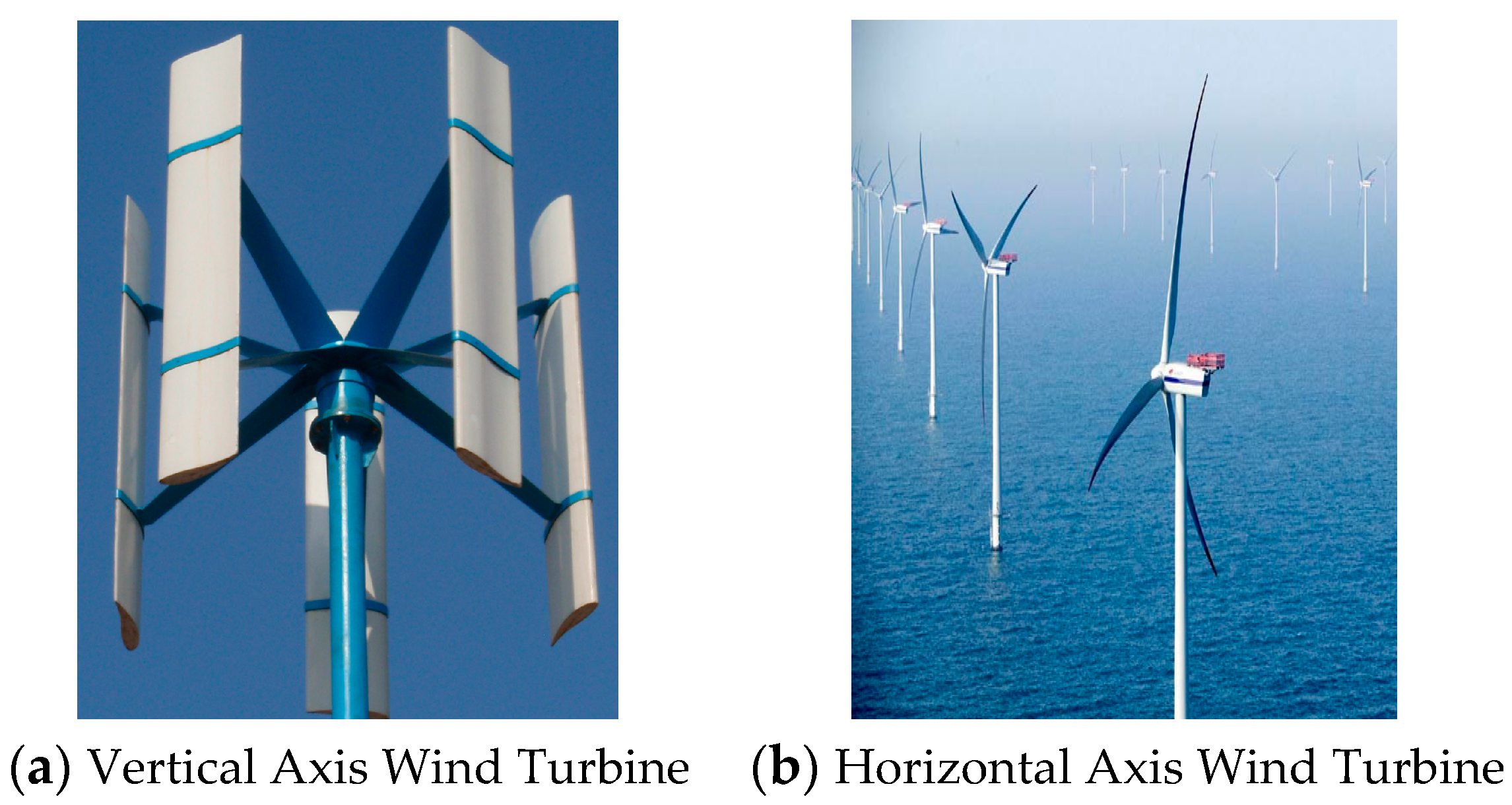
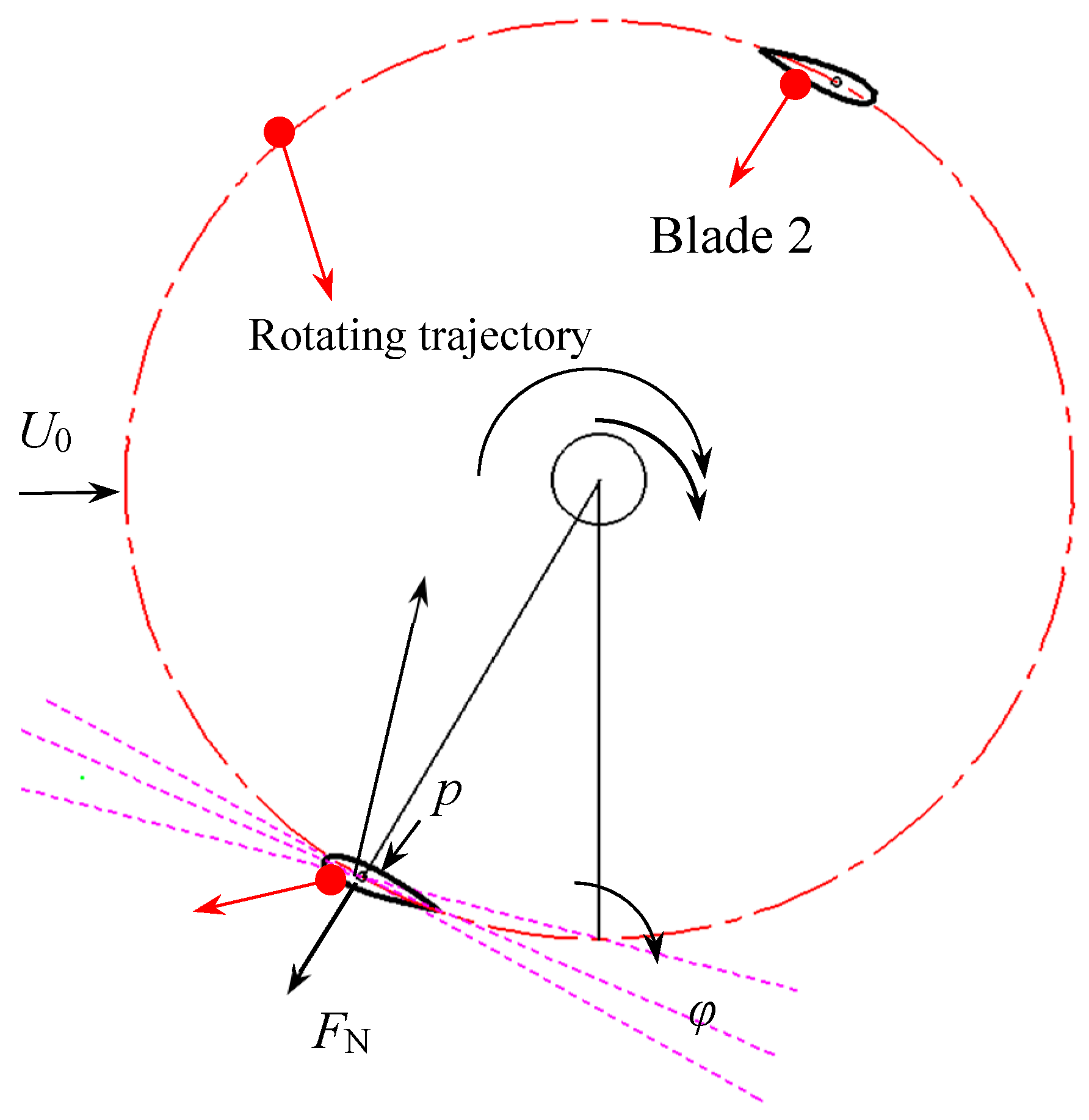
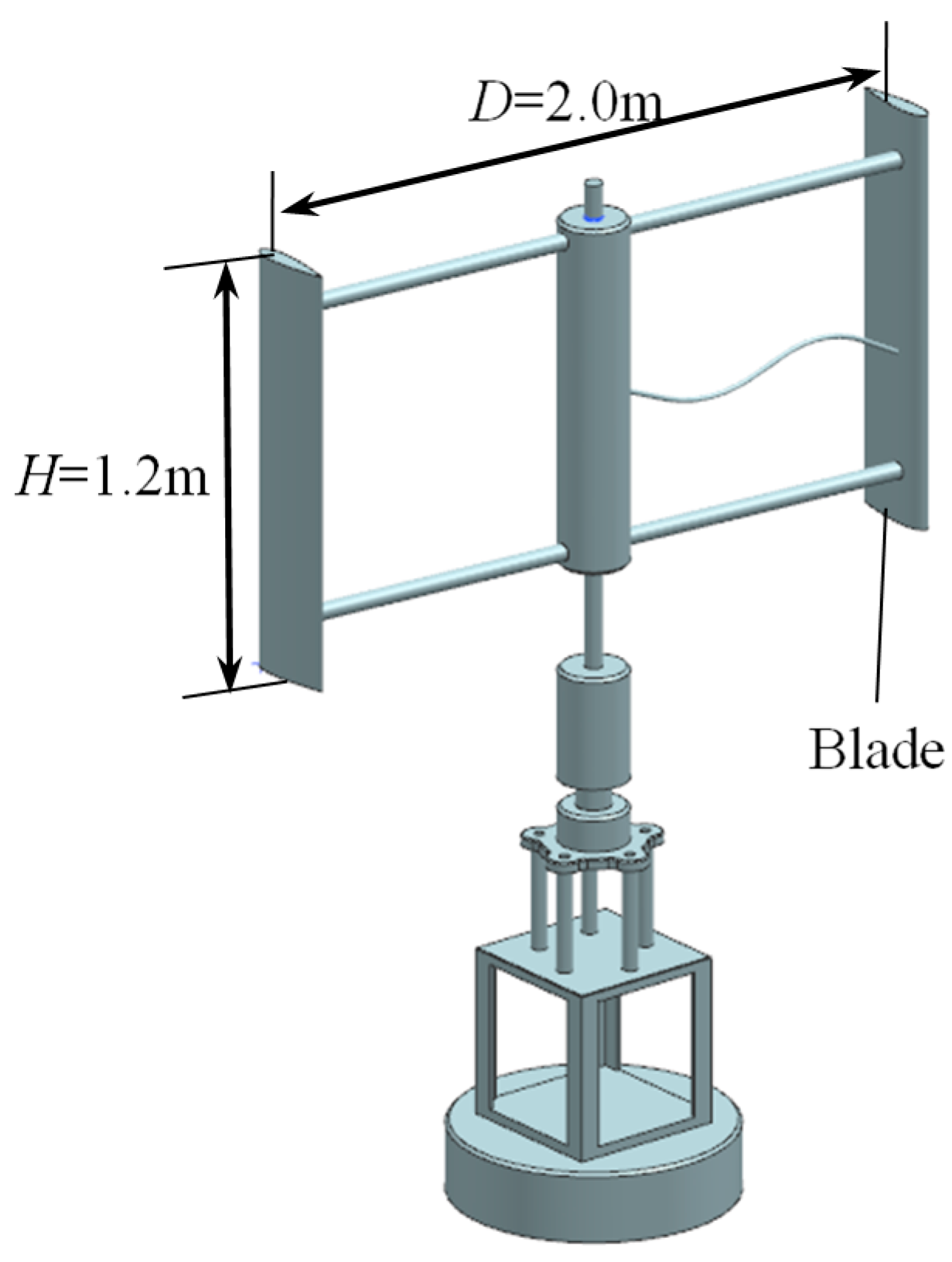
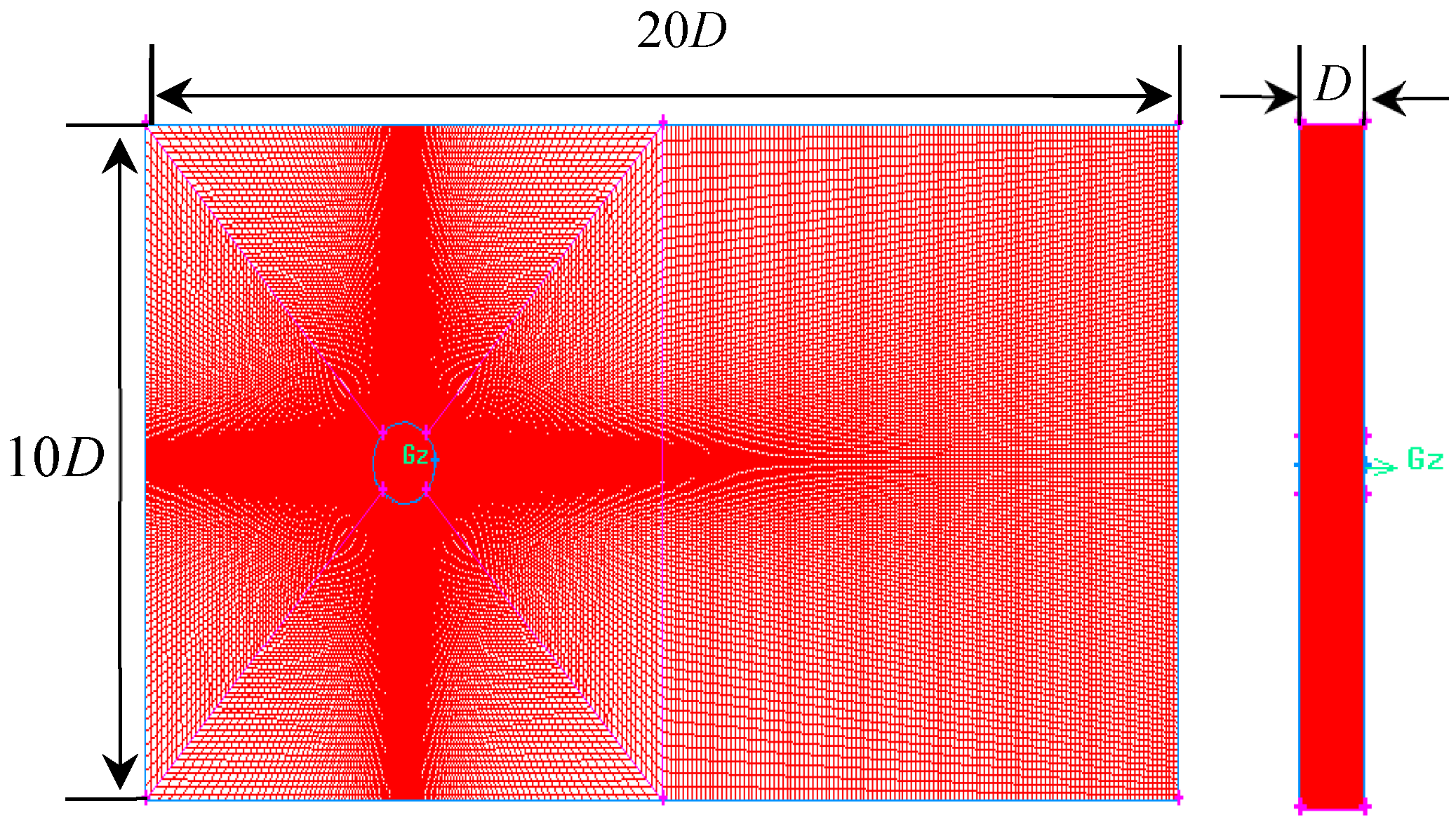
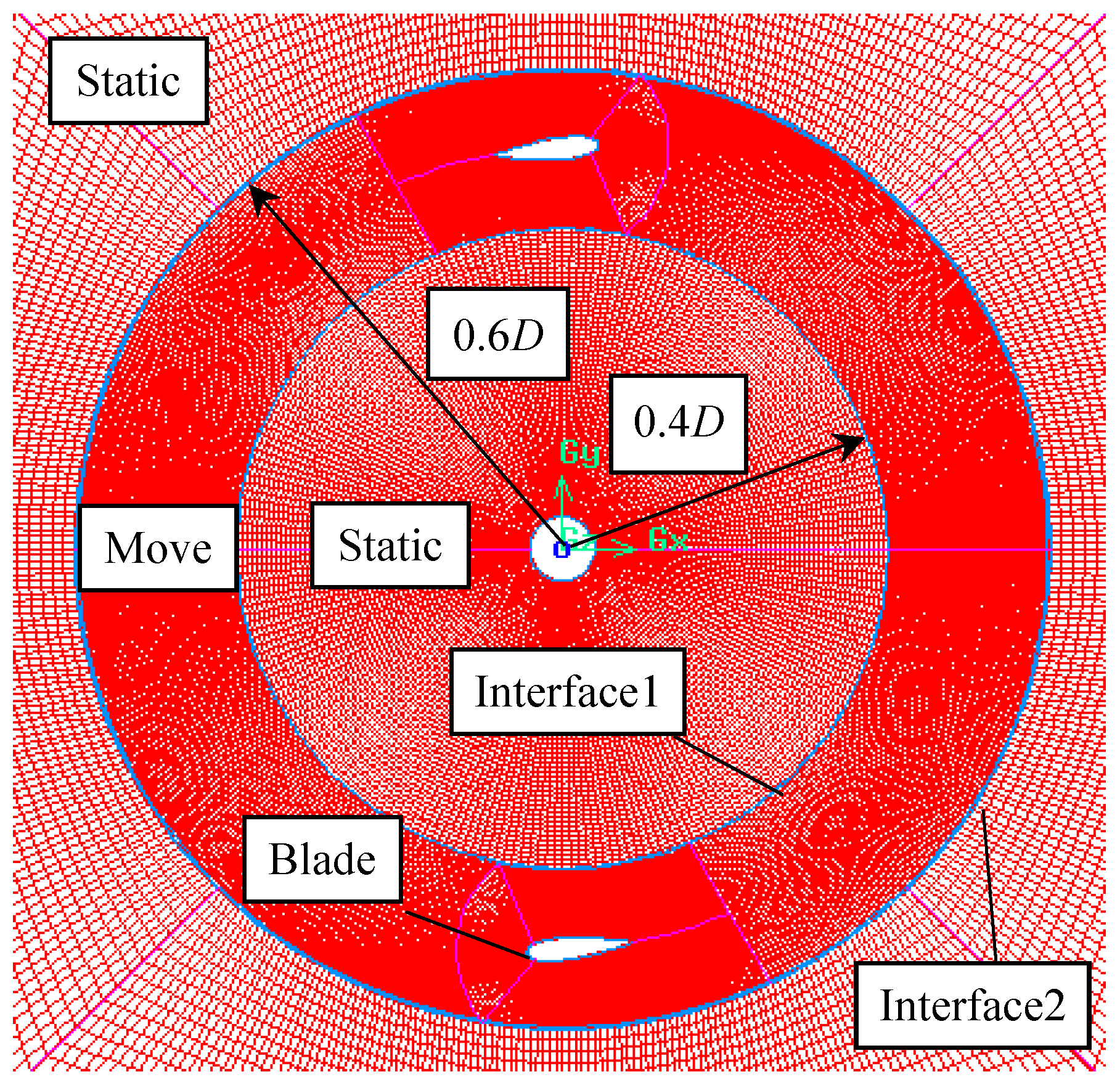
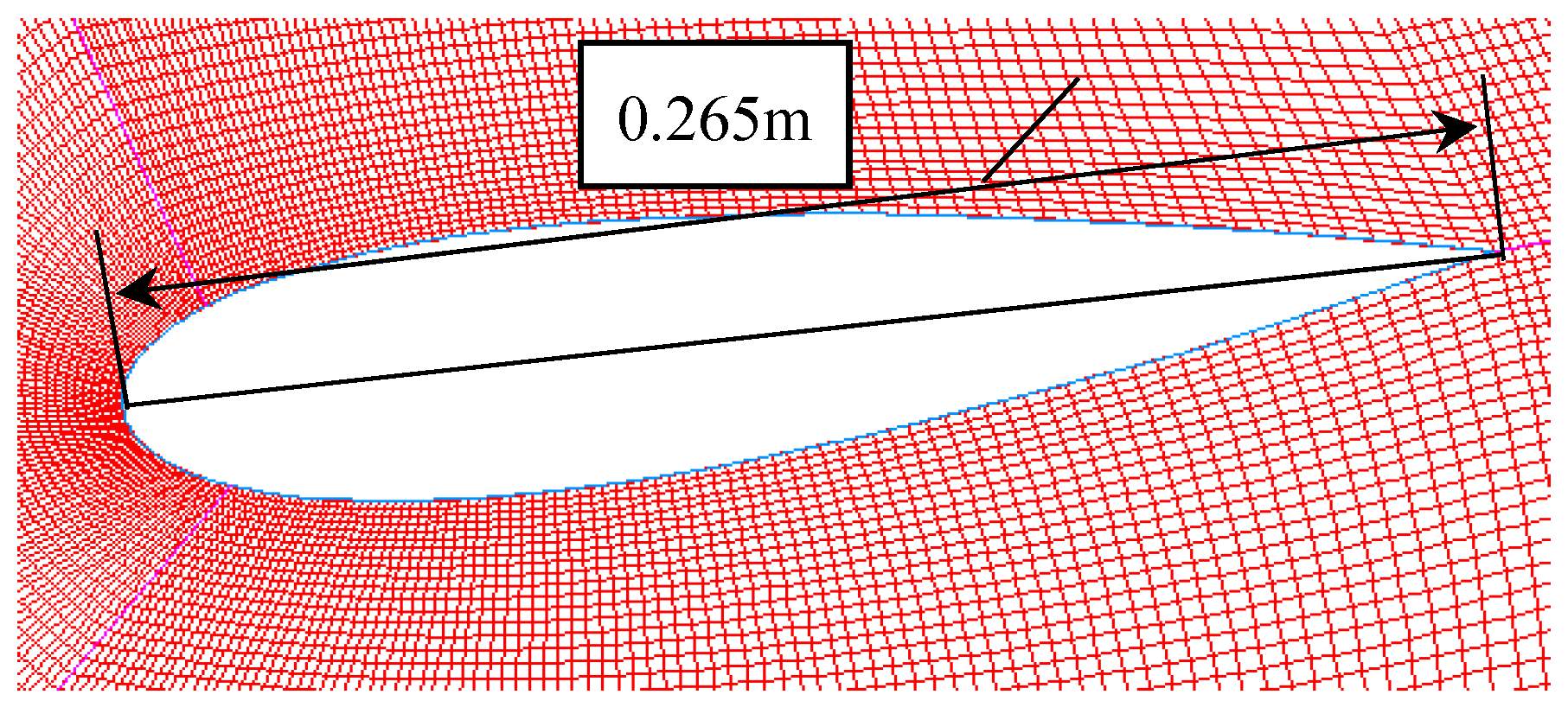
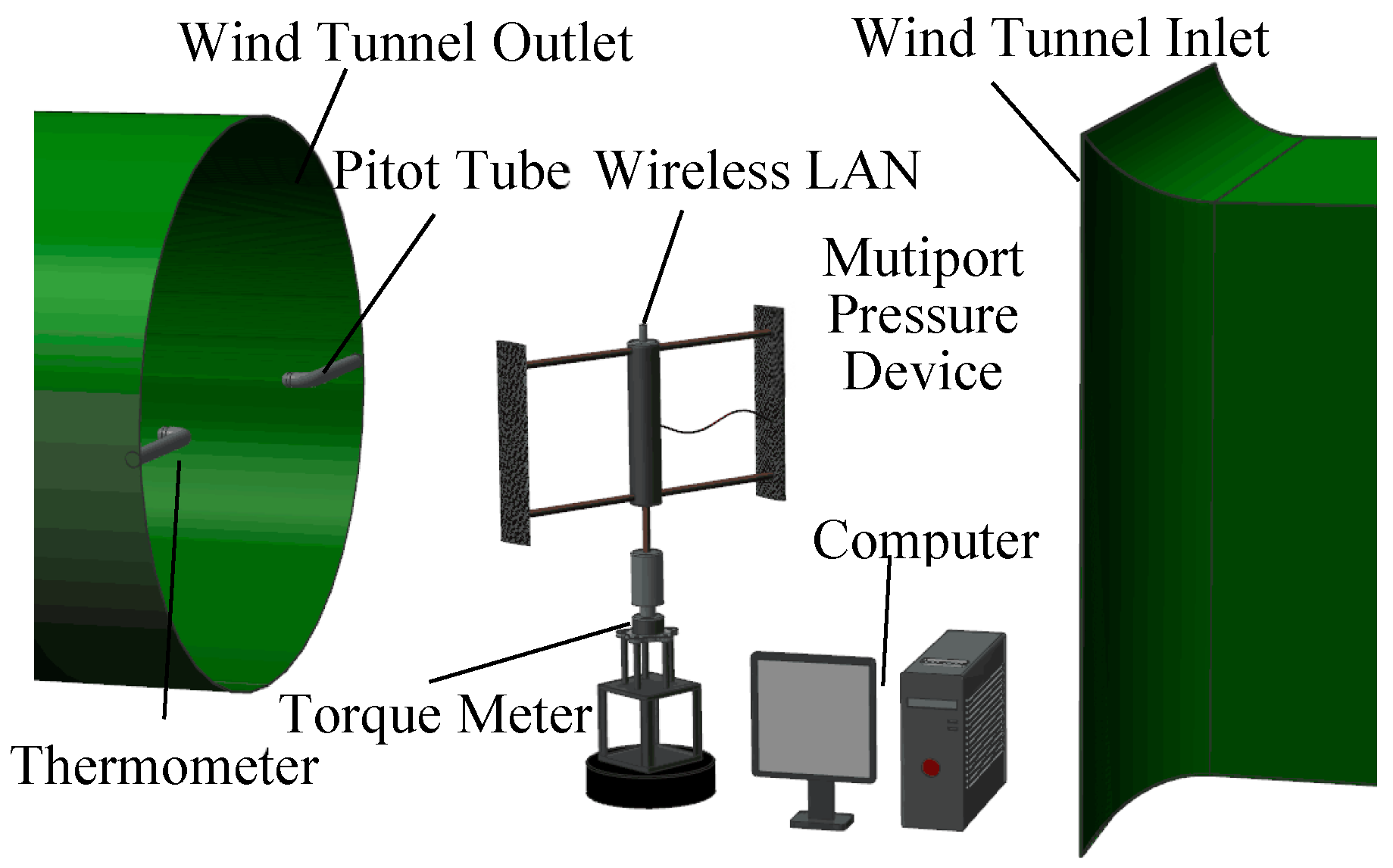
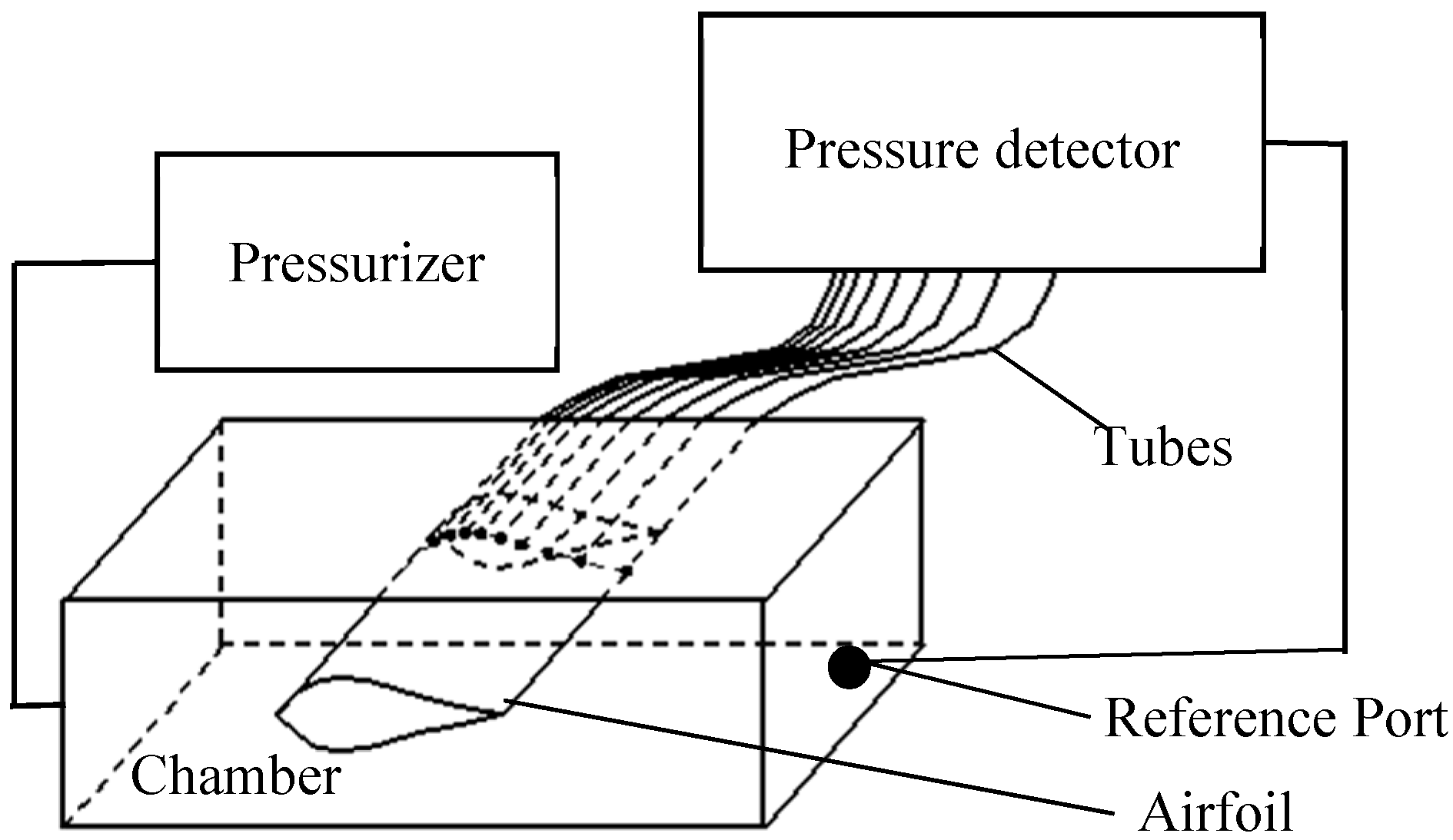
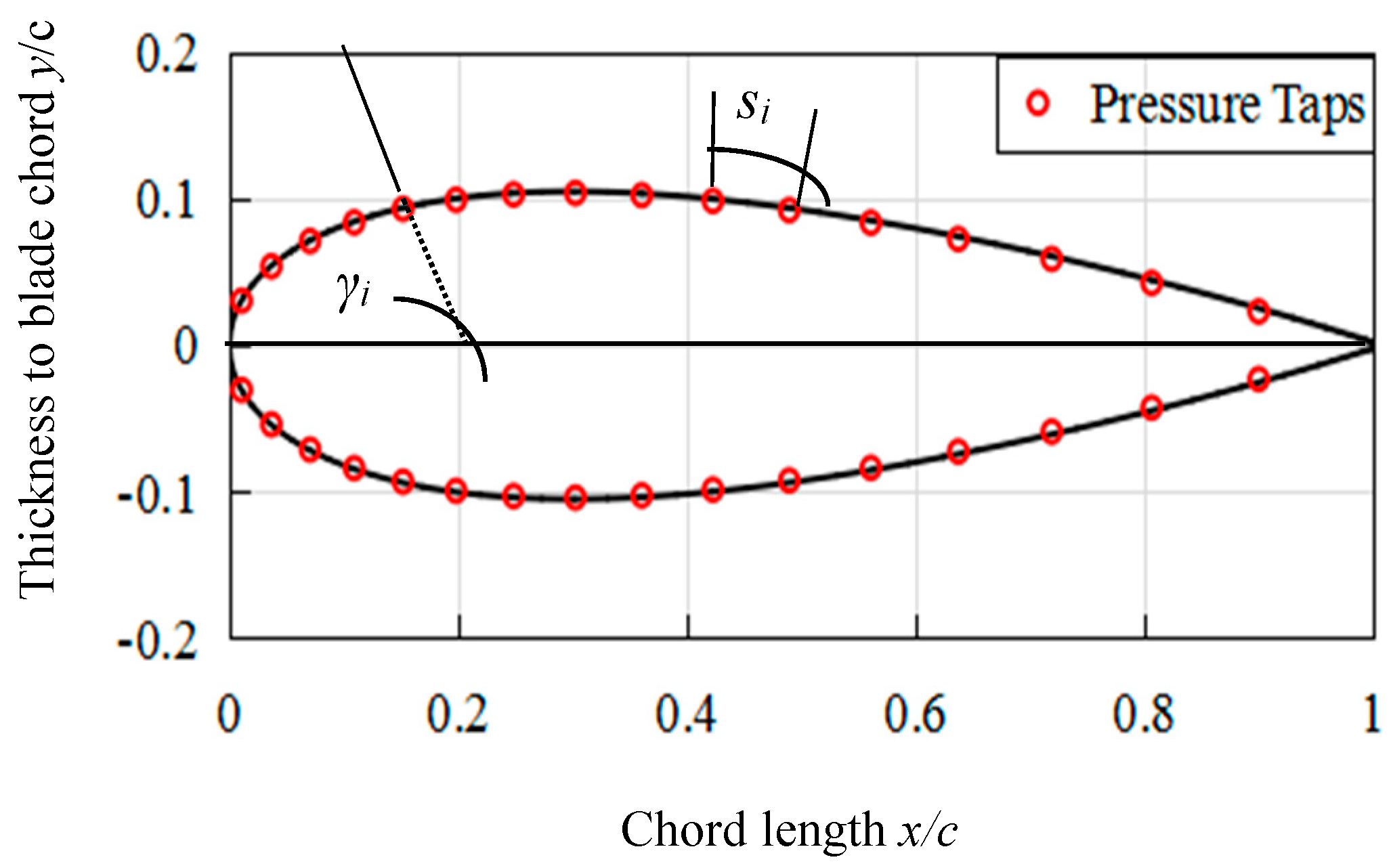
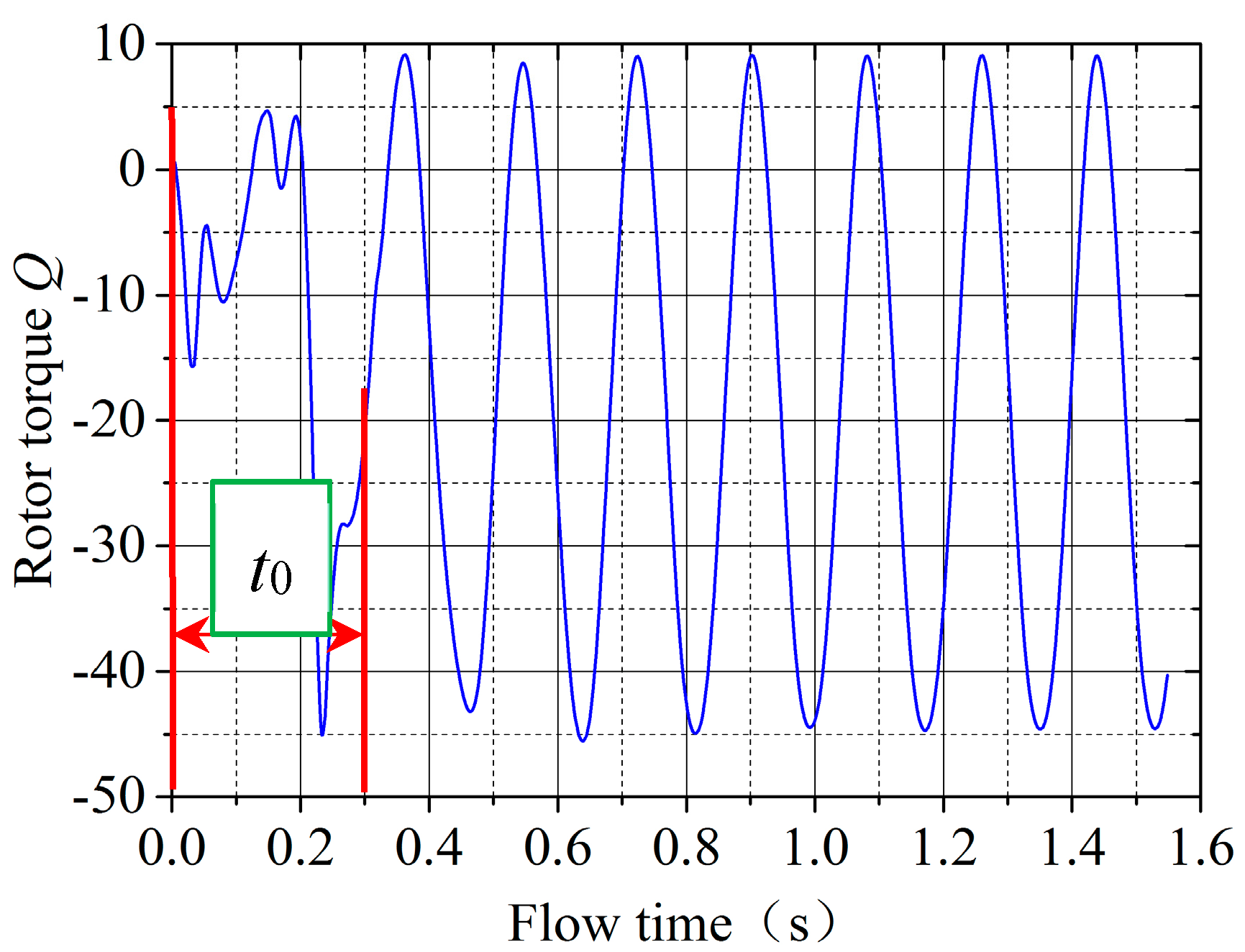
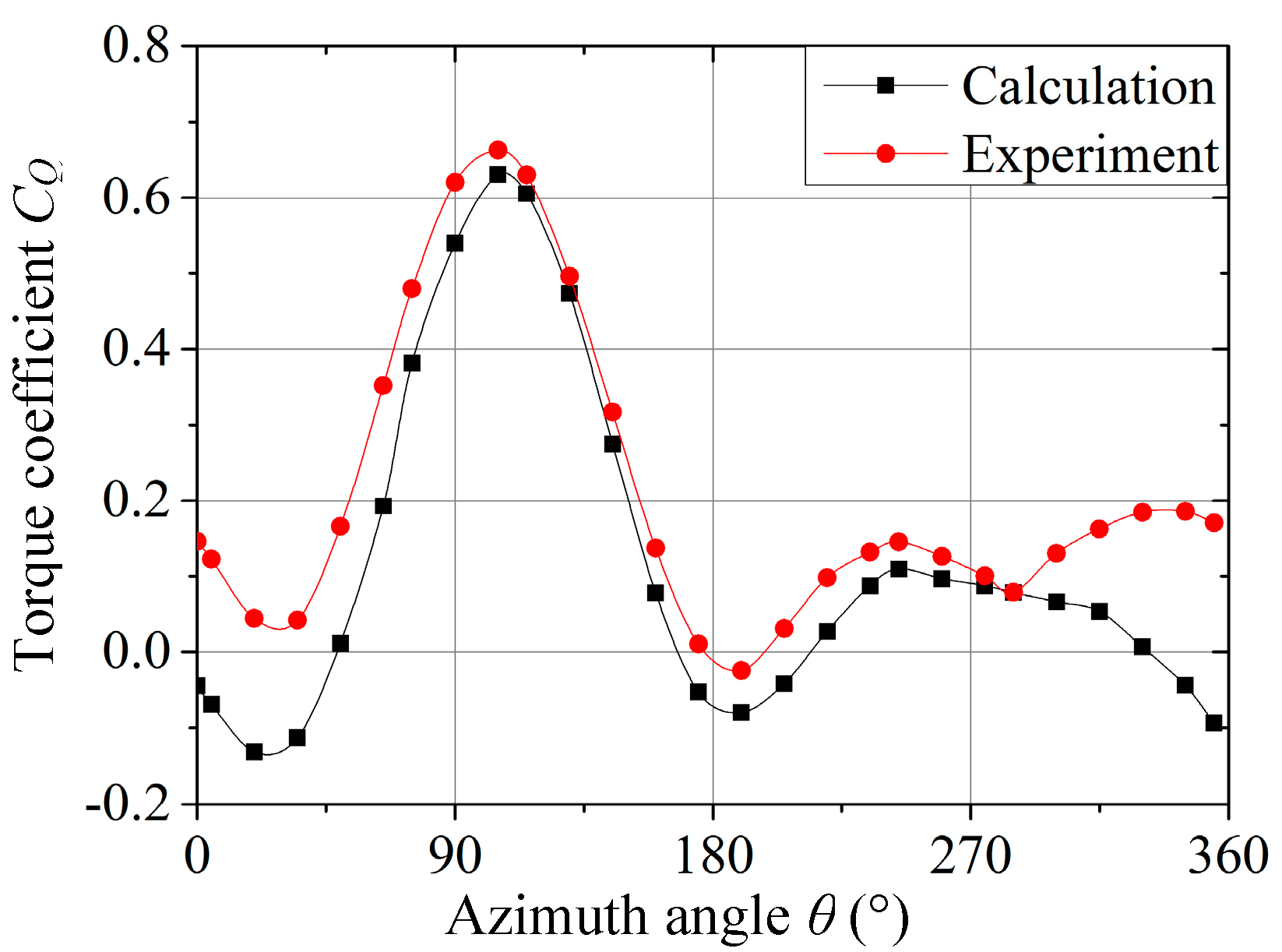
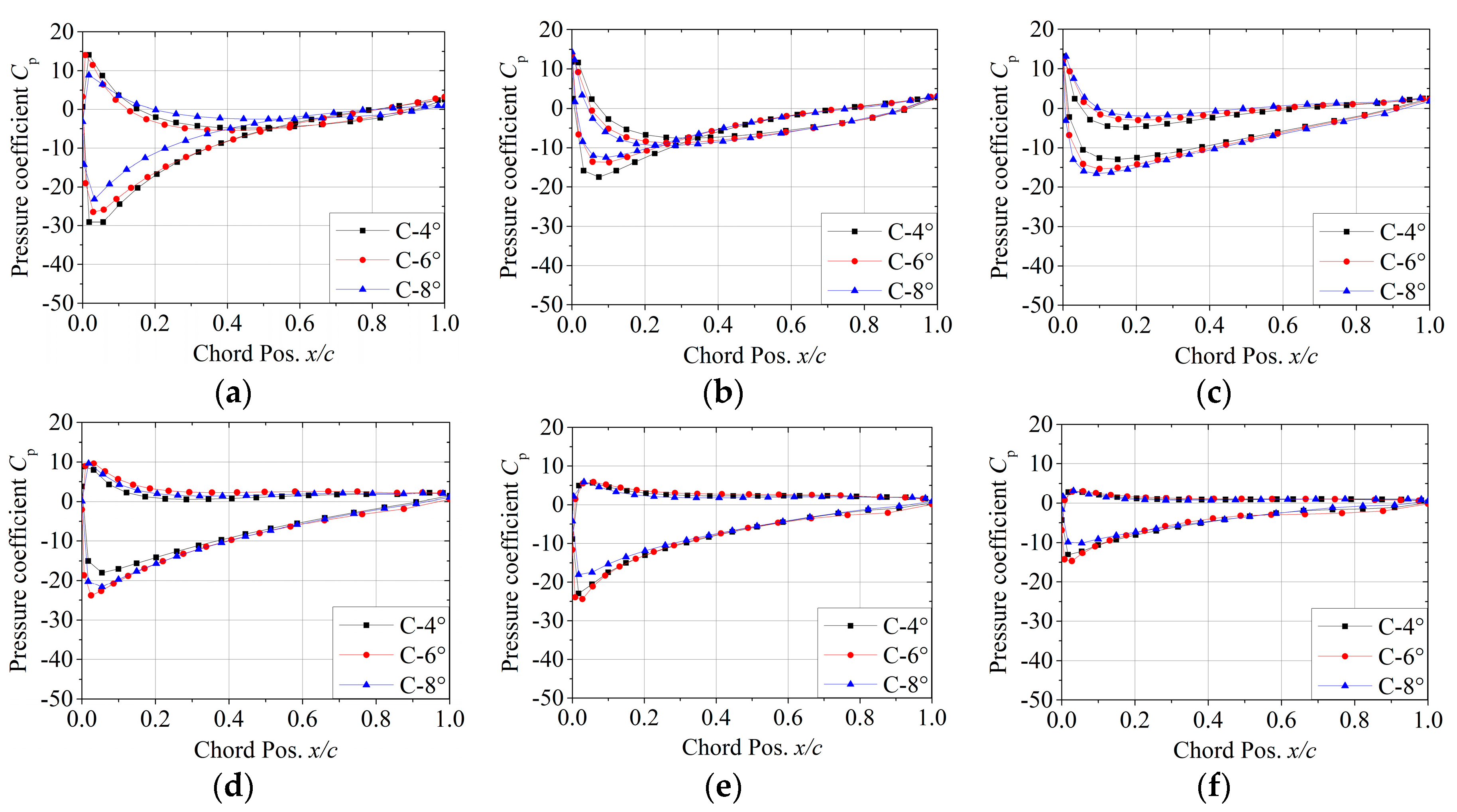
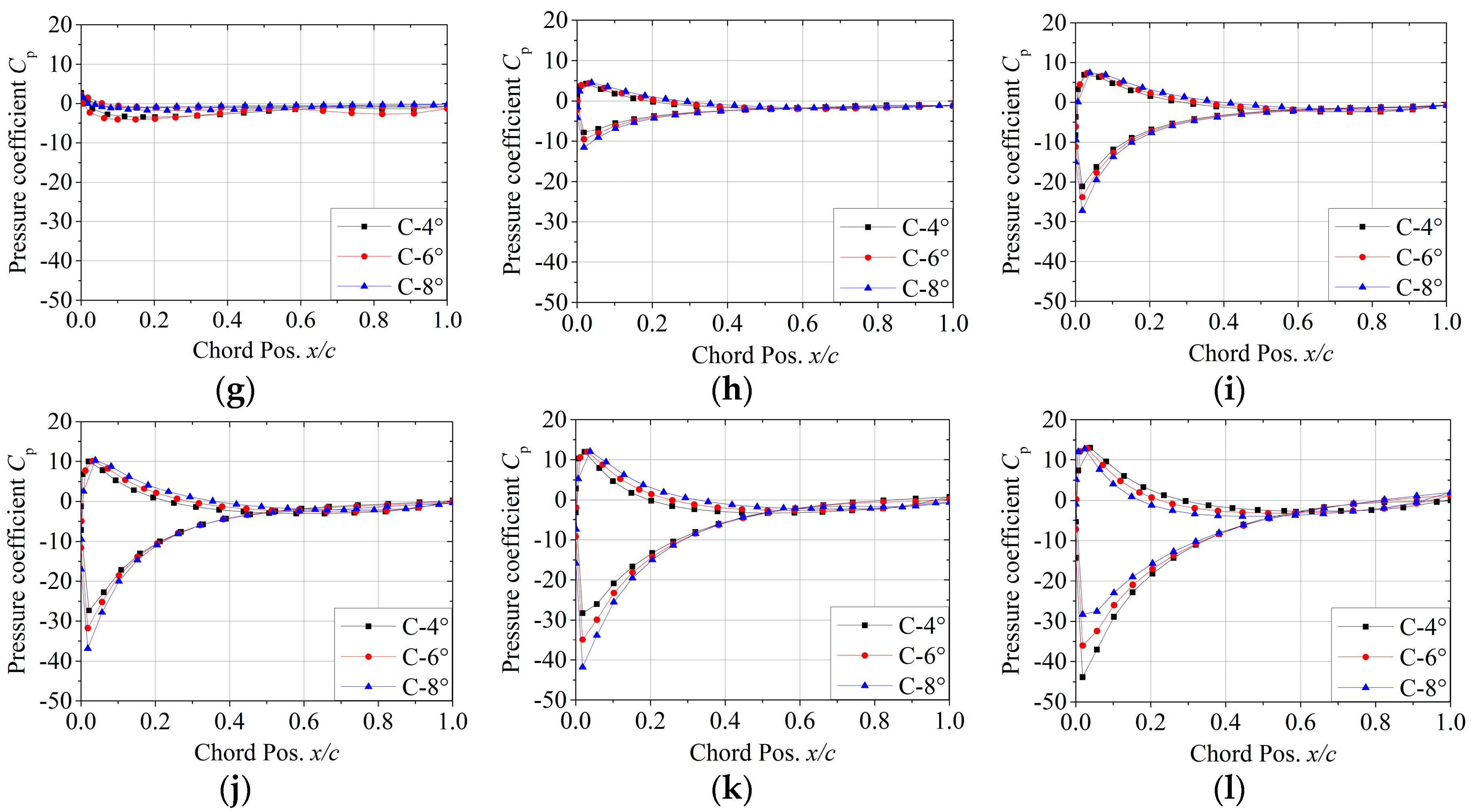
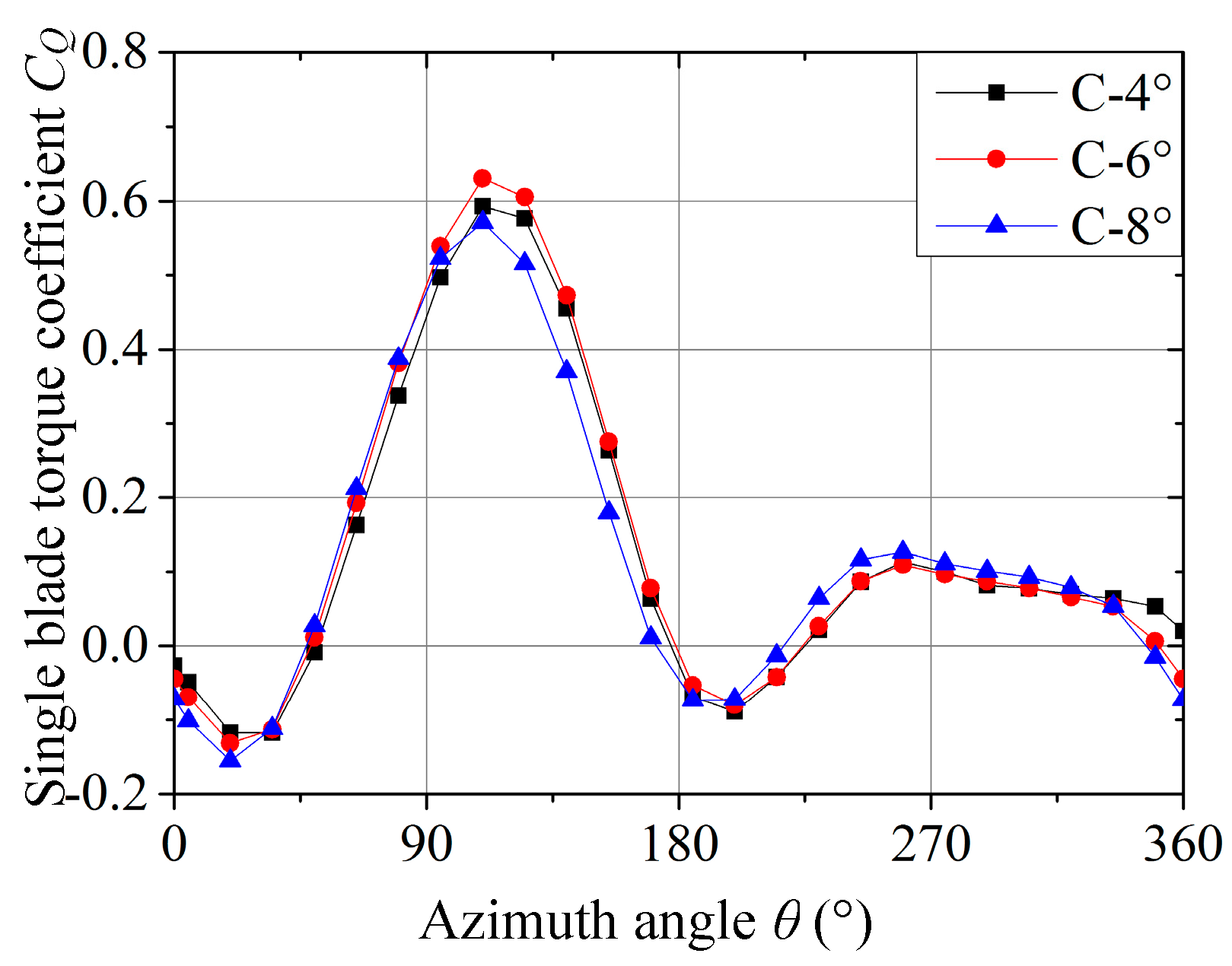
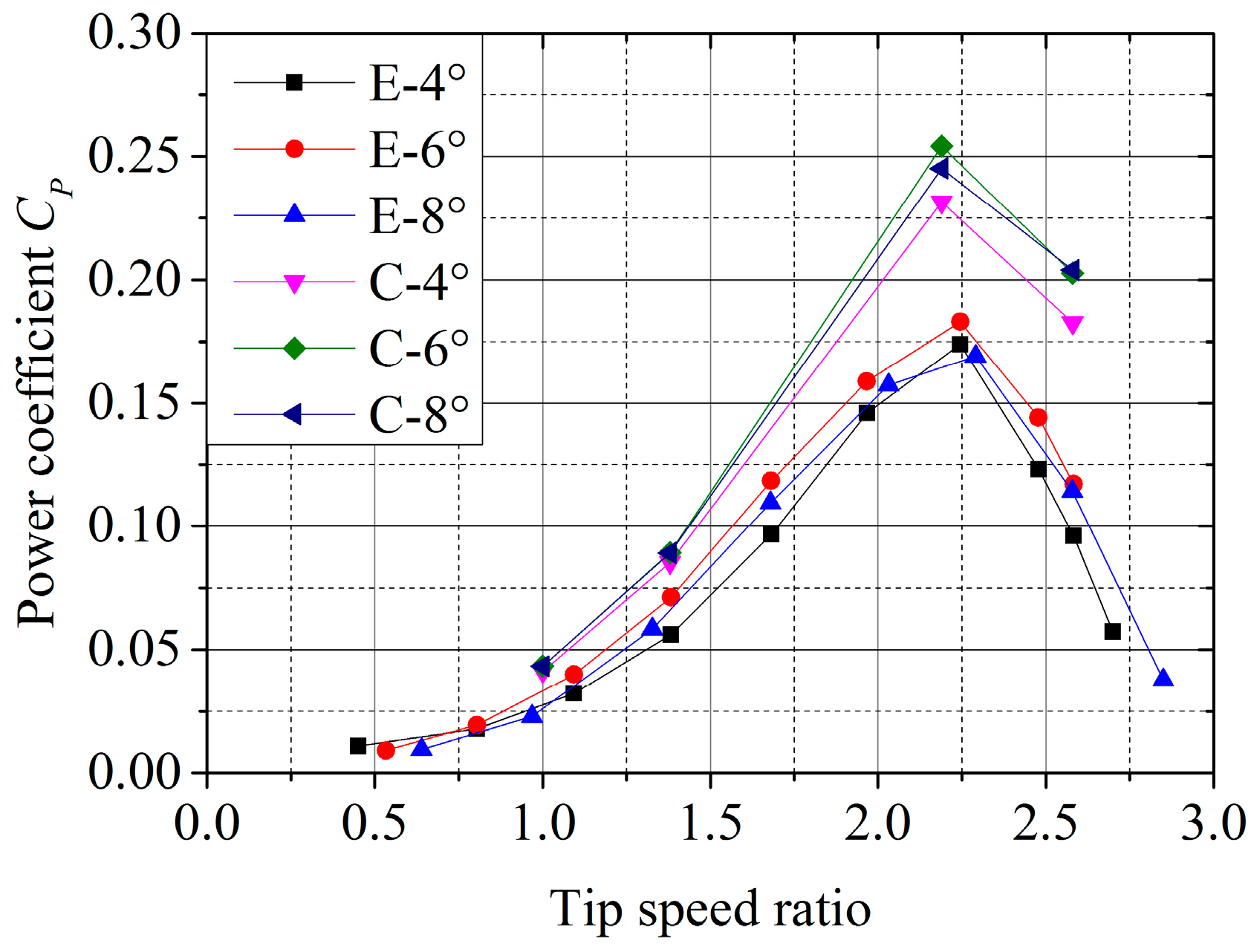
| Type | Boundary Conditions |
|---|---|
| Boundary of inlet surface | Velocity-inlet |
| Boundary of outlet surface | Pressure-outlet |
| Boundaries of other outside surfaces | Symmetry |
| Boundaries of junction surface | Interface |
| Boundaries of blade surfaces | Wall |
| Boundaries of other defaults | Wall |
| Regions | Azimuth Angle | Comparison of Pressure Difference on the Blade Surface |
|---|---|---|
| Upstream region | 0° | 4° > 6° > 8° |
| 30° | 4° > 6° > 8° | |
| 60° | 8° > 6° > 4° | |
| 90° | 6° > 8° > 4° | |
| 120° | 6° > 4° > 8° | |
| 150° | 6° > 4° > 8° | |
| Lower region | 180° | 6° > 4° > 8° |
| 210° | 8° > 6° > 4° | |
| 240° | 8° > 6° > 4° | |
| 270° | 8° > 6° > 4° | |
| 300° | 8° > 6° > 4° | |
| 330° | 4° > 6° > 8° |
© 2018 by the authors. Licensee MDPI, Basel, Switzerland. This article is an open access article distributed under the terms and conditions of the Creative Commons Attribution (CC BY) license (http://creativecommons.org/licenses/by/4.0/).
Share and Cite
Yang, Y.; Guo, Z.; Song, Q.; Zhang, Y.; Li, Q. Effect of Blade Pitch Angle on the Aerodynamic Characteristics of a Straight-bladed Vertical Axis Wind Turbine Based on Experiments and Simulations. Energies 2018, 11, 1514. https://doi.org/10.3390/en11061514
Yang Y, Guo Z, Song Q, Zhang Y, Li Q. Effect of Blade Pitch Angle on the Aerodynamic Characteristics of a Straight-bladed Vertical Axis Wind Turbine Based on Experiments and Simulations. Energies. 2018; 11(6):1514. https://doi.org/10.3390/en11061514
Chicago/Turabian StyleYang, Yanzhao, Zhiping Guo, Qing Song, Yanfeng Zhang, and Qing’an Li. 2018. "Effect of Blade Pitch Angle on the Aerodynamic Characteristics of a Straight-bladed Vertical Axis Wind Turbine Based on Experiments and Simulations" Energies 11, no. 6: 1514. https://doi.org/10.3390/en11061514
APA StyleYang, Y., Guo, Z., Song, Q., Zhang, Y., & Li, Q. (2018). Effect of Blade Pitch Angle on the Aerodynamic Characteristics of a Straight-bladed Vertical Axis Wind Turbine Based on Experiments and Simulations. Energies, 11(6), 1514. https://doi.org/10.3390/en11061514




